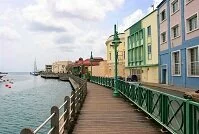Architecture of Barbados

Bridgetown
The architecture of Barbados is quite limited as no true buildings exist from the pre-Columbian times. However, the island has more historic architecture than most of the Caribbean since many early buildings were made from coral, not wood, which was the resource most islands used at the time.
With the British came the Georgian, Jacobean, and the Victorian styles over the colonial years, but these British styles were adopted for Barbados's climate as the buildings tend to be small and triangle in shape to counteract the hurricane and tropical storm winds.
Some of the island's oldest buildings, primarily in the Jacobean style are from the 1600s, including St. Nicholas Abbey (1650s) in St. Peter and the residential Drax Hall (1650s) in St. George, which is a great example of an early sugar plantation master's home.